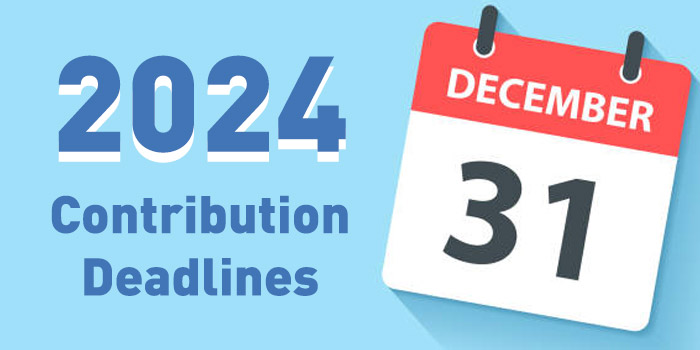As we approach the end of the year, it’s time to think about making the most of your retirement savings. For those nearing retirement, understanding and taking advantage of various contribution deadlines can be a crucial strategy to maximize your wealth and reduce your potential tax liability. Missing these deadlines might mean missing out on valuable tax benefits and growth opportunities.
Let’s dive into the key retirement contribution deadlines you need to know for 2024, along with tips to help you optimize your savings strategy.
- IRA Contribution Deadline: April 15, 2025
Individual Retirement Accounts (IRAs) are a powerful tool for growing your retirement savings with valuable tax benefits. Here’s what you need to know:- Deadline: You have until April 15, 2025 to make contributions for the 2024 tax year. This extended window allows for strategic financial planning, especially if you want to evaluate your tax situation before deciding how much to contribute.
- Contribution Limits: For Traditional and Roth IRAs, the maximum contribution limit for 2024 is $7,000, or $8,000 if you are age 50 or older, taking advantage of the catch-up contribution.
- Tax Benefits:
- Traditional IRA: Contributions may be tax-deductible, potentially lowering your taxable income for the year in which they are made.
- Roth IRA: Contributions are made with after-tax dollars and are not tax-deductible, but qualified withdrawals in retirement are entirely tax-free, offering valuable tax-free income in the future.
Tip: If you haven’t maximized your IRA contributions yet, take advantage of this deadline. This extra time can be especially beneficial for self-employed individuals or small business owners who need to plan around fluctuating income or want to allocate additional savings into a SEP IRA.
- 401(k) Contribution Deadline: December 31, 2024
If you’re participating in an employer-sponsored 401(k) plan, maximizing your contributions is a smart move for growing your retirement nest egg. Here’s the scoop:- Deadline: Contributions for 2024 must be made by December 31, 2024.
- Contribution Limits: For 2024, you can contribute up to $23,000 (or $30,500 if you’re 50 or older, including the catch-up contribution).
- Employer Matching: Don’t leave free money on the table! Ensure you’re contributing enough to receive any employer matching contributions.
- Tax Benefits: Just like with IRA contributions, you can choose to make contributions to Traditional 401(k) or Roth 401(k). Traditional 401(k) is pre-tax while Roth 401(k) is made with after-tax dollars.
Tip: To maximize your contributions, adjust your payroll settings early in the year. This ensures you can spread your contributions evenly and won’t fall short as the year-end deadline approaches.

- Catch-Up Contribution Deadline for Those 50 and Older
If you’re 50 or older, you have the unique opportunity to make catch-up contributions. This additional contribution can help bridge the gap in your retirement savings if you started saving later in life.- IRA Catch-Up: Add an extra $1,000 to your IRA contributions, making the total limit $8,000.
- 401(k) Catch-Up: You can contribute an additional $7,500, bringing your total 401(k) contribution to $30,500 for 2024.
- Deadline: These catch-up contributions must also be made by the IRA deadline (April 15, 2025) and the 401(k) deadline (December 31, 2024).
Tip: Take full advantage of catch-up contributions to significantly boost your retirement savings in the years leading up to retirement.

- SEP IRA and Solo 401(k) Contribution Deadlines for the Self-Employed
If you’re self-employed, a SEP IRA or Solo 401(k) might be part of your retirement strategy. Here’s what you need to know about their deadlines:- SEP IRA:
- You have until April 15, 2025 (or October 15, 2025, with a tax extension) to make contributions for the 2024 tax year.
- Contribution limit: Up to 25% of your net earnings from self-employment, or $69,000, whichever is less. The maximum contribution for 2024 is $69,000.
- Solo 401(k):
- Employee contributions for the 2024 tax year must be made by December 31, 2024. However, employer contributions can be made until April 15, 2025 (or October 15 with an extension).
- Contribution limit: The combined employee and employer contribution limit is $69,000 not counting catch-up contributions for those age 50 and over.
- SEP IRA:
Tip: If you are nearing retirement, maximizing your contributions to a SEP IRA or Solo 401(k) can significantly enhance your retirement savings while also offering a substantial tax deduction.
- Roth Conversion Deadline: December 31, 2024
A Roth conversion allows you to convert pre-tax retirement account funds, such as those in a Traditional IRA or 401(k), into a Roth IRA. This can be a strategic move to reduce your tax liability in retirement, especially if you expect your tax rate to be higher in the future.- Deadline: The conversion must be completed by December 31, 2024, to count for the 2024 tax year.
- Tax Implications: The amount converted is subject to income tax, but future qualified withdrawals will be tax-free.
Tip: If you’re nearing retirement, consider consulting with a financial advisor to determine if a Roth conversion aligns with your tax strategy. It could be an effective way to lock in lower tax rates and ensure tax-free income in retirement.
- Charitable Contribution Deadline: December 31, 2024
Charitable contributions are a meaningful way to give back and can also provide valuable tax benefits if made by the end of the year.- Deadline: To claim a deduction on your 2024 tax return, ensure all charitable contributions are made by December 31, 2024.
- Tax Benefits:
- Standard Contributions: Donations to qualified charitable organizations may be tax-deductible if you itemize deductions, reducing your taxable income for the year.
- Qualified Charitable Distributions (QCDs): If you’re age 70½ or older, you can make a QCD directly from your IRA. This can count toward your Required Minimum Distribution (RMD) for the year, allowing you to satisfy your RMD without increasing your taxable income.
Tip: Consider making a QCD from your IRA if you’re looking for a tax-efficient way to support your favorite causes while potentially reducing your taxable income. This strategy can be especially beneficial for retirees who need to meet their RMD but want to minimize the tax impact.
- RMD Deadline: December 31, 2024
If you’re 72 or older, you’re required to take Required Minimum Distributions (RMDs) from your traditional IRA and other qualified retirement accounts. Failing to do so can result in significant penalties.- Deadline: For most people, RMDs must be taken by December 31, 2024.
- First RMD Year: If 2024 is your first year of RMDs, you have until April 1, 2025 to take your initial distribution. However, this may result in two distributions in 2025 — one for the 2024 tax year and another for 2025 — potentially increasing your taxable income for that year.
Tip: If you’re in your first RMD year, plan carefully to avoid being taxed on two distributions in one year. While you have extra time, taking your RMD by the end of 2024 can help smooth your taxable income for the year and avoid the risk of penalties for non-compliance.

Plan Early and Consult a Financial Advisor
Understanding these contribution deadlines and taking action can help you make the most of your retirement savings opportunities. As we enter 2025, review your retirement accounts and make any necessary adjustments to your contribution strategy.
Don’t wait until the last minute—contributing early in the year not only maximizes your investment time horizon but also ensures you don’t miss any deadlines. If you’re unsure about how to maximize your contributions or have questions about your unique financial situation, consider consulting a financial advisor. They can help you navigate these deadlines and develop a personalized strategy to boost your retirement savings and minimize tax liabilities.
By staying informed about contribution deadlines and making timely contributions, you can take full advantage of tax benefits and set yourself up for a more secure retirement. Don’t let these opportunities slip by—act now to maximize your wealth in 2025!




